Personal preparation for crisis
In the September issue of ÆGIS we wrote about hurricane activity, which we hope was of some before-the-fact help for those who read it before the arrival of Katrina. And in the October issue of ÆGIS we gave some general principles regarding contingency planning for corporations. In this issue we will deal with some of the issues needed for personal survival during a disaster. The items are in alphabetical order, rather than in order of importance. There are two kinds of disasters, each using different pieces of what we will discuss as being needed:
1. Those which you know will come, but not when. This would include earthquakes if you live in Los Angeles, tornadoes if you live in Kansas, or violent faith-based initiatives if you live in New York City. Included in this category would be omnipresent risks, such as fire.
2. Those whose anticipated arrival time is fairly well known, such as hurricanes. Category 4 and 5 hurricanes do not suddenly appear. You know for days that they are coming and, if you have the resources, you can leave before they hit.
It is important to keep in mind that there are crises such as hurricanes in which you may have to flee your home, or a fire in which your home literally goes up in flames and flees you. There are other crises in which you may well find no benefit in fleeing. Thus, if you were in New York City during the last blackout, fleeing wouldn’t help, as there was nowhere nearby that had electricity either. Actually, that is only partly true, as Rockville Centre apparently generates its own power locally, and at much lower cost than the rest of Long Island pays.
Independent of the nature of the crisis, people either will stay but be unprepared, will be unprepared when they try to leave, or will have prepared in advance and stay or leave painlessly. Our goal is to help you be in the prepared group, and so, below, are some of the things you will need to consider.
A Plan
It is important to have a well thought-out plan. You want to have a go-bag with everything you need BEFORE a disaster, rather than trying to put it together at the last minute, when it may be too late. In some cases you and your loved ones may physically be or get separated in a crisis, so it is important, in advance, to have both a plan as to where you will meet, as well as a plan for each of you to call someone well out of the area – personal 800 numbers have helped some in this – who can coordinate where each of you are, and will be, to coordinate a reunion.
If you need to evacuate, your plan must be implemented early, either before you are so bogged down by others leaving that you cannot make progress, or before choices are taken out of your hands and put into those of the authorities. We know of one woman who packed up her kids and drove out of New York City when the first plane hit the Twin Towers. Although she never planed for this particular nightmare, she had planned for a nightmare. There are several ways that the authorities can take control, even if you have left. One is contraflow, where both sides of highways are going in one direction. You may not have exits available, which can be a problem if you need to get gas, or if you need to go in the other direction. Another is that you may be forced into a shelter, or to take government-provided transport.
Batteries
As we travel about in our daily life, we carry our always-present emergency kit (which contains an Xcaper Civilian Smoke Mask (http://www.whiffs.net/), a Smith & Wesson First Response knife (http://shopping.smith-wesson.com), a Storm whistle (http://www.stormwhistles.com/), rappelling gloves, Band-Aids, an aspirin for a heart attack, an Aleve, a few other odds and ends, a SureFire 9N or 9P flashlight with extra batteries, and an extra cell phone battery). In an emergency you need to make sure you have batteries for your radios, flashlights, phones, and anything else you have that takes batteries. At home we have tucked away in the freezer a supply of batteries of various sizes for all our needs. You should see which batteries your various devices use and buy a pack of each for emergency use.
Clothing for various types of weather
In an emergency you may end up going from a place where it is hot to a place filled with snow. As an example, we have friends who, when they evacuate New Orleans, tend to head to Wisconsin. And we saw a lot of people from New Orleans who made it to Gotham, where it was uncharacteristically chilly. They were cold, and not happy.
Flashlights
Flashlights are almost always important during an emergency. Although we ourselves own a variety of flashlights, from duty size to pocket size, and generally carry either a SureFire 9N or 9P which have xenon lamp assemblies, we think that, for emergency use, LED lights are the most appropriate choice because they are harder to break than a standard bulb, and produce a lot of light for the power they consume. In other words, until we reevaluate our choice of which LED flashlight we want to carry, which we are in the process of doing, you should do as we say, not as we do.
We must confess that we have not done our usual extensive, fair, and impartial review of flashlights, largely because we believe SureFire (http://www.surefire.com/) flashlights are the best available. So if you prefer flashlights from some other manufacturer, our not mentioning them does NOT imply that there is a problem with them.

 SureFire at present makes ten LED lights and four LED adaptors for existing lights. Their E1L Outdoorsman is four inches long, weighs 2.6 ounces, is rated to run for four hours on a single battery, and retails for $98. Their E2L Outdoorsman is five-and a-quarter inches long, weighs 3.5 ounces, is rated to run for up to six hours, and retails for $125. Both are excellent choices to have with you.
SureFire at present makes ten LED lights and four LED adaptors for existing lights. Their E1L Outdoorsman is four inches long, weighs 2.6 ounces, is rated to run for four hours on a single battery, and retails for $98. Their E2L Outdoorsman is five-and a-quarter inches long, weighs 3.5 ounces, is rated to run for up to six hours, and retails for $125. Both are excellent choices to have with you.
Flashlights you shake for power are also a good choice for emergency use. One of our editors has 7 of these: One in each bed room, one in the kitchen, and one in each car. They have never failed in 4 years of use and non-use.
Communications
Communications are critically important, and will start to fail as the communications system is stressed, which will be even before a known disaster hits,. In the case of a blackout that lasts a long time, public communications will eventually fail as backup power sources for cellular and landline systems die out.
Portable radio
In an emergency you want to know what is happening in the outside world, and will need a portable radio. Our favorite is the 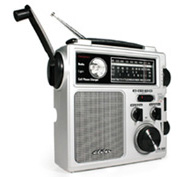 etón FR300 (http://www.etoncorp.com/US/products/product_specs.aspx?specs=true&prodID=20&catID=3&subCatID=7). The FR300 runs off regular power if you get an AC adapter, or three AA batteries, or a built-in dynamo which charges the included nicad batteries.
etón FR300 (http://www.etoncorp.com/US/products/product_specs.aspx?specs=true&prodID=20&catID=3&subCatID=7). The FR300 runs off regular power if you get an AC adapter, or three AA batteries, or a built-in dynamo which charges the included nicad batteries.
The FR300 has AM, FM, TV channels 2 through 13, and all seven NOAA weather stations, including the automatic emergency alert (The Grundig FR200 version has 12 shortwave bands, but that is less useful in the U.S.) In addition, the FR300 has a built-in LED flashlight and a flashing red LED, as well as a siren. Plus, it contains adapters to charge your mobile phone from the dynamo.
The FR300 weighs 20 ounces and costs $50.
Mobile Phones
In the last blackout in New York City, telephones worked as did mobile phones. Well, mobile phones worked for over a day until the cells’ power supplies finally died. For many this was a moot point, as the batteries in their mobile phones died fairly quickly. We had no such problem, as we still have a Nokia 6310i, which, while lacking GSM850 (the U.S. has yet to see a quad-band handset from Nokia), takes batteries that have a standby time of a month, and talk time of up to 20 hours. When we carry other cell phones, we always carry at least one extra battery.
Satellite Communications
In New Orleans, telephone communications died fairly early, so while having a cell phone is important, you shouldn’t count on it working. Your next option is satellite communications (shooting at helicopters to attract attention is not a fruitful idea), which we will describe in detail, as these devices are relatively unfamiliar to most.
The several choices include (in alphabetical order) Globalstar (http://www.globalstar.com/), Inmarsat (http://www.inmarsat.com/), and Iridium (http://www.iridium.com/). Globalstar and Iridium each have handheld devices that are relatively small and convenient to carry. Inmarsat has less-convenient devices, about the size of a laptop computer, which require setup before use (the antenna needs to be pointed toward the satellite).
 We were beta testers of Iridium when it first came out. At that time there were only a small number of us using the system throughout the world, and we still got circuit busies most of the time. We have since tried the system again, and can confirm that the system works.
We were beta testers of Iridium when it first came out. At that time there were only a small number of us using the system throughout the world, and we still got circuit busies most of the time. We have since tried the system again, and can confirm that the system works.
 Similarly, we tested a GSP-1600 and had no problem. The GPS-1600 can be set to first try to find a domestic 800 MHz CDMA or AMPS signal, which will be a good thing if the cellular system is working, and you have the feature enabled. As an interesting side note, Globalstar uses CDMA technology, which is also used by mobile service providers like Sprint and Verizon. In the voice world, CDMA is interesting largely because it is based on a spread spectrum concept originally patented by actress Hedy Lamarr. While CDMA has a number of theoretical advantages, in cities, where system implementation is largely dictated by buildings, the advantages give no particular benefit over other approaches. But satellite systems are freed from that constraint, and in this system theoretical benefits have become practical benefits.
Similarly, we tested a GSP-1600 and had no problem. The GPS-1600 can be set to first try to find a domestic 800 MHz CDMA or AMPS signal, which will be a good thing if the cellular system is working, and you have the feature enabled. As an interesting side note, Globalstar uses CDMA technology, which is also used by mobile service providers like Sprint and Verizon. In the voice world, CDMA is interesting largely because it is based on a spread spectrum concept originally patented by actress Hedy Lamarr. While CDMA has a number of theoretical advantages, in cities, where system implementation is largely dictated by buildings, the advantages give no particular benefit over other approaches. But satellite systems are freed from that constraint, and in this system theoretical benefits have become practical benefits.
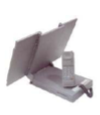
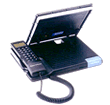 We ourselves mostly use the Inmarsat system. We own O’Gara Compact M (left, 11lb 7.6oz), and Thrane and Thrane TT-3060A Mini-M (right, 6lb 10oz) terminals. In general we use (and recommend) Mini-M terminals, but in some exotic locations the heavier (and more expensive per minute) M will give us coverage where the Mini-M won’t. In other locations it will give us a shot at two satellites and be a better choice in spite of the weight.
We ourselves mostly use the Inmarsat system. We own O’Gara Compact M (left, 11lb 7.6oz), and Thrane and Thrane TT-3060A Mini-M (right, 6lb 10oz) terminals. In general we use (and recommend) Mini-M terminals, but in some exotic locations the heavier (and more expensive per minute) M will give us coverage where the Mini-M won’t. In other locations it will give us a shot at two satellites and be a better choice in spite of the weight.
Satellite phones are all about tradeoffs among geographical coverage (you must have an unobstructed view of a satellite for the phone to work), weight, reliability, voice quality, and cost.
Geographical coverage
Iridium has the best coverage of the three, with actual worldwide coverage (given the caveat that you must be able to see the 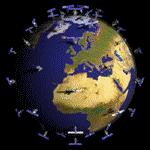 satellite). So if you are going to be at the North or South Poles, this is your only choice. If you have an unobstructed view of the sky where a satellite is located you simply raise the antenna, dial the phone number, and hit the talk button.
satellite). So if you are going to be at the North or South Poles, this is your only choice. If you have an unobstructed view of the sky where a satellite is located you simply raise the antenna, dial the phone number, and hit the talk button.
Inmarsat uses geostationary satellites over the Equator, which means that if you are north of the equator you need an  unobstructed view south, and North if you are below the Equator. Because the world is round, there is no coverage roughly above the Arctic Circle or below the Antarctic Circle. In effect, you have coverage in 98 percent of the world. Inmarsat M service has global coverage in this full area. Inmarsat Mini-M service, which uses more powerful spot coverage, works on the major land masses, but won’t have coverage in, say, the middle of the Atlantic between Brazil and Africa, or the South Pacific. For most of us, lack of coverage mid-ocean really doesn’t matter, which is why we recommend the Mini-M over the M. You can see the Inmarsat coverage map, including the spot coverage, at http://fleet.inmarsat.com/pdf/Fleet_coverage_map.pdf.
unobstructed view south, and North if you are below the Equator. Because the world is round, there is no coverage roughly above the Arctic Circle or below the Antarctic Circle. In effect, you have coverage in 98 percent of the world. Inmarsat M service has global coverage in this full area. Inmarsat Mini-M service, which uses more powerful spot coverage, works on the major land masses, but won’t have coverage in, say, the middle of the Atlantic between Brazil and Africa, or the South Pacific. For most of us, lack of coverage mid-ocean really doesn’t matter, which is why we recommend the Mini-M over the M. You can see the Inmarsat coverage map, including the spot coverage, at http://fleet.inmarsat.com/pdf/Fleet_coverage_map.pdf.
Using an Inmarsat terminal involves more steps than using an Iridium or Globalstar device, both of which works like cell phones. With an Inmarst terminal you have to align the antenna at the satellite. The easy way to do this is to look in the phone’s manual, which will give a set of maps with pointing instructions. Your longitude will tell you the direction (the book may call it the azimuth) in which to point the antenna (a compass will be included with the phone), and your latitude will tell you the amount it has to be tilted up or down. If you are fussy, you can look at the tables in http://www.inmarsat.com/files/download.aspx?file=Handbooks/Inmarsat%2 0Maritime%20Handbook/Apendix-C-ed.pdf and calculate what it should be.
Keep in mind that the azimuth is relative to true north, not magnetic north, so you should know the magnetic declination of your location, which will be given as some number of degrees East or West, and which you will use to go from magnetic to true. To make life easier, just remember the old pilot’s motto of “Compass to True, add East.” Or you can just point the antenna in the magnetic direction and move it left and right until you get the strongest signal indicated. Once you have a strong signal you pick up the handset, listen for the dial tone, and dial the number followed by #, remembering that in the satellite world long distance – which is everywhere – is indicated with the European 00 prefix.
As always, you must keep in mind that for a satellite phone to work you must be able to see the satellite – or at least where it is. So if you are using an Inmarsat system on the north side of a mountain north of the Equator you may have to do some climbing to get a clear shot to the south.
GlobalStar has coverage in the Americas, Europe, and Australia, much of Asia, excluding China, the Indian subcontinent, 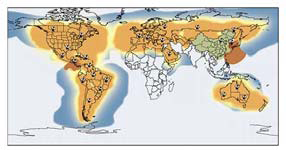 and some of Southeast Asia. It is the only sitcom system that will work in the Grand Canyon, albeit not all the time: Depending on the moment, the satellites may not be in the right position, but at least you have a shot at communication at some point. While Globalstar may have less coverage than Inmarsat or Iridium, remember that in practical terms coverage and lack of coverage in areas that you will never visit doesn’t matter.
and some of Southeast Asia. It is the only sitcom system that will work in the Grand Canyon, albeit not all the time: Depending on the moment, the satellites may not be in the right position, but at least you have a shot at communication at some point. While Globalstar may have less coverage than Inmarsat or Iridium, remember that in practical terms coverage and lack of coverage in areas that you will never visit doesn’t matter.
As with Iridium, if you have an unobstructed view of the sky where a satellite is located you simply raise the antenna, dial the phone number, and hit the talk button. You can see the Globalstar coverage map at http://www.globalstarusa.com/en/content.php?cid=300.
Weight
Globalstar and Iridium have handheld terminals (the Globalstar GSP-1600 is 13.5 ounces. The Iridium 9505a is 13.2 ounces). Inmarsat Mini-M terminals (and the Compact M system we use) are about the size of laptops. As noted, the Mini-M weighs about six pounds and the M twelve. If you are absolutely not going to be carrying the equipment on your back this is not an issue. If you are, we can assure you that twelve pounds is a lot. Usama Bin Laden used the model Compact M we use, and we bet he had someone carry it for him.
Reliability
All three systems work, but you can expect to have occasional dropped calls. In our experience, if you have a clear sight toward the equator and can pick up a strong Inmarsat signal you are unlikely to have a problem making a call, and will have a low probability of the call being dropped. Globalstar has occasional drops, and Iridium has somewhat more. We have, on occasion – particularly in large cities where use of a satellite phone is inappropriate and iffy because of the buildings – had to make a second call. Considering how often our cell phones drop calls, and how often we have to retry with VoIP lines, we don’t consider this to be a real issue.
Voice Quality
Globalstar has great voice quality. People often think we are calling on a cell phone when we make Globalstar calls. Inmarsat is almost as good, but the experienced can pick up the telltale signs of it being a high orbit satellite system. Iridium is less good. In all cases the quality, at worst (albeit sometimes with a second call), should be acceptable.
Cost
Cost for our purposes has two parts. The first is the cost of the equipment.
Globalstar handsets cost around $645 at the Scandinavian Ski Shop (http://www.skishop.com/) in Manhattan (212-757-8524). Iridium handsets cost around $1,500. Inmarsat Mini-M terminals start around $2,500. If you want the Compact M terminal we use, you can get one for $599 (plus the cost of batteries) from Dylan Callahan at http://www.cidwireless.com/ (1- 631-961-9643). You can find used satellite handsets and terminals for less on eBay.
The second cost is the monthly or yearly cost, or the per-minute cost for use. Our Inmarsat M contract had no activation fee, and has no monthly fee. On the other hand, it costs us $2.65 a minute for calls, so don’t expect us to be too chatty if we call you. Our Mini-M system cost under $2 per minute. You can also get pre-paid calling cards, and if we lend one of our Inmarsat terminals to you, we will NOT give you our smart card. At $1.90 to $2.65 a minute we would rather have you get your own, thank you very much. We have our minutes supplied by Jack Lemmerman at Satcom Distribution, 1- 631-586-5100 (http://www.satcomgroup.com/).
With Iridium you can buy pre-paid cards or have an account. There may be activation fees and monthly fees, with minutes costing around $1.50.
Globalstar does not yet have pre-paid cards, though we suspect they are considering it. They offer free 911 calls in the U.S., and the service works with their Mobile Position Determination which displays the user’s lat / long on the phone screen while in a call. Not as accurate as GPS but handy to narrow down the search area.
Globalstar’s pricing is at http://www.globalstarusa.com/en/airtime/voicepricing/, and plans start at $1.00 a minute. Oddly, if you have Globalstar service, a call to the U.S. from abroad can be cheaper than on your cell phone. Thus, a call from Turkey(a place we can safely admit to having visited recently) costs $1.39/minute on Globalstar, and $1.99 on T-Mobile. But it is cheaper still to have a local SIM and use a callback service.
Emergency Location
Whistles
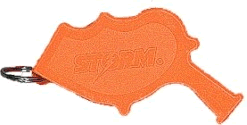 We discussed the use of whistles in the September 2004 ÆGIS. Whistles are important in attracting attention because you cannot yell very loudly for very long. While we gave a number of choices for general consideration, for use in our traveling emergency rescue kit we chose the Storm from the All Weather Whistle Company (http://www.stormwhistles.com/storminfo.html). We believe the Storm to be the loudest whistle available, and at a retail price of $5.50 you can’t afford not to have one in your emergency kit.
We discussed the use of whistles in the September 2004 ÆGIS. Whistles are important in attracting attention because you cannot yell very loudly for very long. While we gave a number of choices for general consideration, for use in our traveling emergency rescue kit we chose the Storm from the All Weather Whistle Company (http://www.stormwhistles.com/storminfo.html). We believe the Storm to be the loudest whistle available, and at a retail price of $5.50 you can’t afford not to have one in your emergency kit.
Personal Locator Beacon
If you are trapped somewhere, with no possibility of contact with the outside world, you can still let people know where you are, and that you are in trouble, if you have a Personal Locator Beacon (PLB), which we discussed in the October 2003 ÆGIS. When activated, the PLB sends out a signal which will be picked up by satellite, with your location – within 100 feet – then sent to the appropriate country for relay to search and rescue. An additional signal is transmitted for local capture, which will lead your rescuers right to you. It is our current belief that the GPS enabled locator should be one which functions for 48 hours, not 24 hours. While it is true that the signal will be captured within minutes, it is quite possible that nobody will be in a position to rescue you immediately. You would like to maximize the likelihood of someone finding you, and the extra day seems prudent to us. As with all satellite based systems, you will need to have a view of the sky toward the SARSAT (http://www.sarsat.noaa.gov/) satellites for the device to do its job. As of4 November 2005, 27 lives in 14 incidents have been saved in the U.S. through use of PLBs. Worldwide, including all beacons, not just PLBs, over 18,500 people have been rescued since 1982.
 Our current recommendation is the Microwave Monolithics MicroPLB GX (http://www.micromono.com/microplb/microplb.html). We like its size and duration, plus it has some features that seem novel and important. Two examples are its fast on-time to full bust transmission, and its ability to update the GPS almanac. This latter means that, as satellites slowly drift out of orbit over time, the location shown can be a trifle off. The GX allows you to hop get off the plane in Uzbekistan and assure yourself that the device’s accuracy is as current as is possibly before setting off into the countryside.
Our current recommendation is the Microwave Monolithics MicroPLB GX (http://www.micromono.com/microplb/microplb.html). We like its size and duration, plus it has some features that seem novel and important. Two examples are its fast on-time to full bust transmission, and its ability to update the GPS almanac. This latter means that, as satellites slowly drift out of orbit over time, the location shown can be a trifle off. The GX allows you to hop get off the plane in Uzbekistan and assure yourself that the device’s accuracy is as current as is possibly before setting off into the countryside.
Food
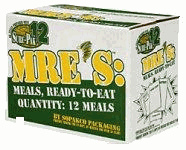 It is appropriate to have three days of food in case of an emergency. Since there is a good possibility you may lose power, it is best to have this in some non-perishable form, which means either canned, or dried (rice and beans don’t go bad), or in the form of MREs – Meals, Ready to Eat – which you can keep for a very long time. MREs come in a variety of menus, and don’t taste bad at all. The package shown is the civilian version of the MREs made by Sopakco for the military, and distributed by its sister companyCrown Point(http://www.crownpt.com/). A carton of MREs, containing a dozen meals, costs around $70.
It is appropriate to have three days of food in case of an emergency. Since there is a good possibility you may lose power, it is best to have this in some non-perishable form, which means either canned, or dried (rice and beans don’t go bad), or in the form of MREs – Meals, Ready to Eat – which you can keep for a very long time. MREs come in a variety of menus, and don’t taste bad at all. The package shown is the civilian version of the MREs made by Sopakco for the military, and distributed by its sister companyCrown Point(http://www.crownpt.com/). A carton of MREs, containing a dozen meals, costs around $70.
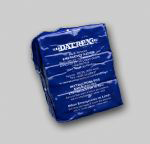 In addition, Datrex (http://www.datrex.com/) make high-carb (3,600 calories per package of 18 200 calorie bars) bars that will give you a lot of energy, yet take relatively little space. They can be heated or eaten cold. The package of bars, approved for lifeboat use, costs around $7.
In addition, Datrex (http://www.datrex.com/) make high-carb (3,600 calories per package of 18 200 calorie bars) bars that will give you a lot of energy, yet take relatively little space. They can be heated or eaten cold. The package of bars, approved for lifeboat use, costs around $7.
Also, since the power may go out, either empty your refrigerator before you leave, or, if you think that there is a chance the power will not go out, at least double wrap all the food in heavy plastic bags. This way, if you are wrong, you will throw out the bags, not the entire contaminated refrigerator.
Guns
In times of emergency it may not seem entirely imprudent to have a gun to be able to defend yourself if things get out of hand. But keep in mind that this happens very infrequently and if you use government transport, your gun may be either taken away permanently, or taken away temporarily.
In any case, you should only carry a gun if you know how to use it. This means that if you don’t normally carry a gun, this is not be the best time to start. As in normal life, a personal defense spray (we carry PUNCH from AERKO, http://www.aerko.com/) will be more appropriate, with the caveat that if you need a gun, there is no adequate substitute.
As with a gun, you should not carry a spray if you don’t know how to use it.
While not related to self defense, it is always both appropriate and prudent to have a Gerber Tool (http://www.gerbergear.com/), a Leatherman tool (http://www.leatherman.com/), or a Swiss Army Knife (http://www.victorinox.com/). These will always prove to be more useful to you in your daily life, crisis or not, than a gun. This means that if you don’t normally carry a personal defense spray, this is not be the best time to start.
Important Documents
Documents need to be complete and up to date. You must get these before the emergency takes place. You should plan ahead, and regularly update your records.
• Medical Records. These should be complete and up to date.
• Financial records, debit card, check book.
• Ownership records. Mortgage papers, title papers, land records, etc., Insurance records on land. Car records, car insurance, and personal insurance papers are all important. If you rent, make sure you have renters insurance, and copies of the papers.
• Registration records.
• Birth Certificates, wills, marriage certificate, organ donor records.
Make copies of all your important documents, and send them to people in other areas, so that you are assured of being able to 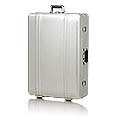 get copies in a timely manner. How can you take these with you? We know people who use large Zero Halliburton suitcases for this. These are the aluminum cases you always see spies using in the movies, and current ones are available with wheels, or wheels and a handle. Their largest case is 32 × 29 × 10, and will hold over three cubic feet – about six milk crates – of stuff. Zero Halliburton (http://www.zerohalliburton.com/) makes very tough cases. There is a story of an Algerian terrorist blowing up a plane on a runway in France, after having discharged all the passengers: The only recoverable items were in Halliburton cases. If you can live without wheels – the cases will probably just be tossed in the trunk of your car – they can be purchased quite inexpensively on eBay. Both editors of AEGIS use Halliburton cases, with one case, purchased in 1965 for use in the Peace Corps, looking the same today as when it was purchased.
get copies in a timely manner. How can you take these with you? We know people who use large Zero Halliburton suitcases for this. These are the aluminum cases you always see spies using in the movies, and current ones are available with wheels, or wheels and a handle. Their largest case is 32 × 29 × 10, and will hold over three cubic feet – about six milk crates – of stuff. Zero Halliburton (http://www.zerohalliburton.com/) makes very tough cases. There is a story of an Algerian terrorist blowing up a plane on a runway in France, after having discharged all the passengers: The only recoverable items were in Halliburton cases. If you can live without wheels – the cases will probably just be tossed in the trunk of your car – they can be purchased quite inexpensively on eBay. Both editors of AEGIS use Halliburton cases, with one case, purchased in 1965 for use in the Peace Corps, looking the same today as when it was purchased.
Keep in mind that having offsite copies of your documents is a good idea independent of the nature of the crisis. If you should have the misfortune to have your house burn down – which is more likely than your being the victim of an act of nature or an act of terrorism – you will find yourself needing to deal with this minor-to-others-but-major-to-you disaster as best you can. Having your documents still available to you will be very helpful indeed.
Maps and GPS System
Maps generated on the computer are often straight-through, with no exit points. We also find they tend to be annoyingly inaccurate as you approach your final destination. It is better to have real maps with you, and a good idea to have a GPS system that is current, so that if you need to take a exit for some reason, you can still wend your way to where you need to go. Keep in mind that your destination might not remain constant. In the case of a hurricane, for example, a few degrees difference in landfall can greatly change the area through which you want to drive
Medication/Glasses/Hearing Aid
Get your pharmacist to transfer a copy of all of your pharmaceutical needs to a major national pharmacy such as Walgreen or Wal-Mart. Have at least one – preferably two – pairs of glasses with you.
Have a copy of your hearing aid warranty and six packs of extra batteries. Note what kind of battery you use in case you still need to get more.
Most important of all, have enough of any critical medication with you to last at least two weeks, on the off chance that you are trapped, unable to get more in a timely manner.
Money
One of the clearest things that came out of the Katrina experience was the importance of not being poor. Unfortunately, while this is, in theory, straightforward long-term (Finish high school. Don’t have children until you are married. Don’t get married before twenty.), we have no short term solution to the problem, and conveniently assume that our readers are, in fact, not poor.
ATMs may not work because both the ATM and the responding bank need power and telephones. Thus, you should carry cash. According to friends who have been fleeing New Orleanson a regular basis, you should ideally carry $5,000. Keep most in a safe in the vehicle. If you can’t do that, make sure you have a money belt. Travelers’ checks don’t work everywhere, but take some of them if you feel more comfortable doing so.
If you have your account in a local bank there is a good chance that the computers out of the disaster area will not be able to speak with the computers in the disaster area, and you may not have access to your funds for a long time.
Shelter
If you are forced into a public shelter, there may well be no bedding, so plan on bringing your own, as well as an inflatable pillow. Since the environment may become unhealthy, a supply of inexpensive bio-hazard masks is a good idea, as well as copious amount of hand sanitizer.
It may also be possible to prearrange post-evacuation shelter with relatives or friends. These people should be relatively distant from your disaster location, and relatively good friends or close relatives.
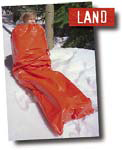 In case you are stuck in adverse – cold – conditions you should have a Mylar thermal blanket, as well a Thermal Protective
In case you are stuck in adverse – cold – conditions you should have a Mylar thermal blanket, as well a Thermal Protective  Aid. A Thermal Protective Aid is designed to provide insulation to persons in a life raft as required by Chapter 3 Solas 1974/96. While we hope you will not be in a life raft, a TPA will keep you warm no matter where you are. Some come in the form of a large bag, and come as suits. They come in very small packages. They are made by a number of suppliers: Datrex makes TPAs, as does (left) Ocean Safety (http://www.oceansafety.com/), and (right) Corporate Air Parts (http://www.land-shark.com).
Aid. A Thermal Protective Aid is designed to provide insulation to persons in a life raft as required by Chapter 3 Solas 1974/96. While we hope you will not be in a life raft, a TPA will keep you warm no matter where you are. Some come in the form of a large bag, and come as suits. They come in very small packages. They are made by a number of suppliers: Datrex makes TPAs, as does (left) Ocean Safety (http://www.oceansafety.com/), and (right) Corporate Air Parts (http://www.land-shark.com).
TPAs cost around $40.
Transportation
Boat, plane, or train
If you are lucky, you will have access to a boat or plane to get away. You will need transportation at the other end, but that should be less of a problem than getting away in the first place. Boats can be particularly good, yet overlooked. In the case of an emergency inManhattan, most people will think of escape by car, but, in reality, a boat trip via the scenic Hudson might be the best choice. And don’t rule out trains if they go from where you are to an unaffected area.
Automobile, and some driving suggestions
An automobile will be the most common choice for transport. Make sure the car is roadworthy, and that the spare tire is inflated, and you have a full set of basic auto tools, road safety gear, and maps.
It is even more important during an emergency than it is in normal times that your gas tank should never go below half full. Since you should stop every two to two and a half hours to stretch, the half-tank mark will be a good time to think about getting gas and taking a break. It is important to drink water and consume complex carbohydrates while traveling, and you might do that while getting gas if you don’t feel like eating while driving.
Remember that the earlier you leave, the less traffic you are likely to hit: Even in an emergency many people don’t want to leave home at 4am. If you arrive at an overnight stop between 3:30 and 5 you will have a better chance of getting a hotel room than if you arrive later.
On the other hand, you may be forced to drive until it is dark, especially if you are trying to get as far away as you can as soon as you can. To maximize your night vision, during the day you should wear AV/UV sunglasses while driving, and keep them on until the sun goes down. Amber glasses are a good choice, as they add clarity to the world. They distort color, but that is less of a problem when driving than when flying, when the colors on a map can be very significant.
If you face flooding and will not be taking your car, consider driving it onto a big tarp and tying the tarp over the car. The car might float away in open water, but if it can’t float too far you could come home to an un-ruined vehicle.
Bicycle
A folding bike is good to have, or, if space is not a concern, a mountain bike, which will eliminate fear of damaging a tire. A glow-in-the-dark vest, with flashing light if you travel at night, will be important. Toe clips are ok, as long as you can get feet out quickly. You will need reflective devices, and a light capable of shining 15 feet in front of you.
Foot
You need to know where you are going before you leave the safety of where you are at. You need a plan. How far will I travel before resting, hydrating, and consuming calories? A handheld GPS is invaluable when traveling by foot, particularly if you are going off road. Walking poles can be a help.
Water
In general, a water purifier is not necessary in urban setting, where you can – and should – always store a several day supply of water. Indeed, in normal circumstances we may filter the water so it looks, tastes, and smells good, but we are not concerned with it being unsafe to drink. This may change in times of crisis, depending on the circumstances.
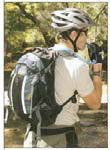 Even in a time of crisis water is normally available save in panicstricken areas. But you will need to carry water. We prefer to carry water in a Camalbak (http://www.camelbak.com/), which allows you to carry water on your back relatively comfortably, and to sip as you go along. Camelbaks even come built into a knapsack, which is convenient both when walking and cycling. It is better to store water in your body than on your back, so drink as much water as you can when the opportunity presents.
Even in a time of crisis water is normally available save in panicstricken areas. But you will need to carry water. We prefer to carry water in a Camalbak (http://www.camelbak.com/), which allows you to carry water on your back relatively comfortably, and to sip as you go along. Camelbaks even come built into a knapsack, which is convenient both when walking and cycling. It is better to store water in your body than on your back, so drink as much water as you can when the opportunity presents.
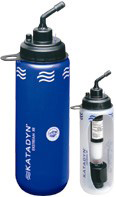 Depending on the nature of the emergency, you may be in a place where the water supplies are contaminated. Our camper friends recommend Katadyn products (http://www.katadyn.com/us). Katadyn makes a variety of filters and, more important, purifiers (which cost half again as much as a filter). We have their EPA registered Exstream XR Bottle Purifier, which retails for under $50.
Depending on the nature of the emergency, you may be in a place where the water supplies are contaminated. Our camper friends recommend Katadyn products (http://www.katadyn.com/us). Katadyn makes a variety of filters and, more important, purifiers (which cost half again as much as a filter). We have their EPA registered Exstream XR Bottle Purifier, which retails for under $50.
Another possibility is water purifying tablets, such as Katadyn’s Micropur MP1 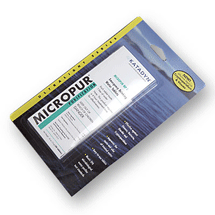 Purification Tablets. Micropur retails at $13.95 for a pack of 30, with each tablet purifying a liter of water. Depending on whether the water is clear or dirty, warm or cold, Micropur can kill everything (bacteria, cysts, and viruses) in your liter of water in 15 minutes for warm clear water or 4 hours for cold dirty water. Once purified, a few coffee filters should clear the water nicely in the field (we have used this method when camping). If home, a kitchen or bathroom filter should deal with any taste or smell issues. Water purifying tablets and a filter (rather than a purifier) is a reasonable option.
Purification Tablets. Micropur retails at $13.95 for a pack of 30, with each tablet purifying a liter of water. Depending on whether the water is clear or dirty, warm or cold, Micropur can kill everything (bacteria, cysts, and viruses) in your liter of water in 15 minutes for warm clear water or 4 hours for cold dirty water. Once purified, a few coffee filters should clear the water nicely in the field (we have used this method when camping). If home, a kitchen or bathroom filter should deal with any taste or smell issues. Water purifying tablets and a filter (rather than a purifier) is a reasonable option.
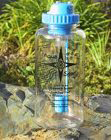 An attractive alternative to water purifying tablets (and a good item to pack on trips where the local water might be iffy) is the AquaStar Plus (http://uvaquastar.com/), which bombards your liter of water with ultra-violet C light, which kills bacteria, cysts, and viruses (including those that would slip through normal filters) in a liter of water in 80 seconds (two cycles if colder than 40°). It also has a camping light built in. The AquaStar Plus uses a pair of the same CR-123 lithium batteries we use in our SureFire flashlights. The AquaStar Plus costs $95, but they have some inventory of last year’s model (without the camping light and updated timing circuit) discounted to $60.
An attractive alternative to water purifying tablets (and a good item to pack on trips where the local water might be iffy) is the AquaStar Plus (http://uvaquastar.com/), which bombards your liter of water with ultra-violet C light, which kills bacteria, cysts, and viruses (including those that would slip through normal filters) in a liter of water in 80 seconds (two cycles if colder than 40°). It also has a camping light built in. The AquaStar Plus uses a pair of the same CR-123 lithium batteries we use in our SureFire flashlights. The AquaStar Plus costs $95, but they have some inventory of last year’s model (without the camping light and updated timing circuit) discounted to $60.
With some forethought and preparation – and a healthy dose of good fortune – a disaster will hopefully be survivable for each of us, and those who war within our care.

